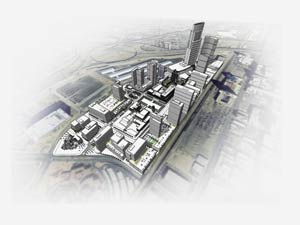
Las Vegas Readies Brownfield For Green Revitalization
 |
Union Park as envisioned by the city of Las Vegas. Source: Newland Communities |
Union Park in downtown Las Vegas is one of the most ambitious brownfield redevelopment programs in the country. The project aims to convert more than 61 acres of a former rail yard and maintenance facility into a green urban destination -- complete with a towering skyline.
In fact, the estimated $6-billion project is the only one in Nevada to be accepted into the Leadership in Energy and Environmental Design for Neighborhood Development (LEED®-ND) national pilot program and has recently been awarded Gold certification status under stage 2 by the U.S. Green Building Council.
The success of Union Park depends on the cleanup of petroleum-impacted soils. "The city of Las Vegas has long recognized the potential of the Union Park site as a catalyst to downtown redevelopment," said Scott D. Adams, the city's director of business development. "That’s why site cleanup has always been a top priority. It’s allowing us to reclaim the very heart of our city and to put downtown Las Vegas on the map with the city’s most impressive collection of important civic, medical, and cultural facilities."
Remedial action that took place in the mid-1990s called for a partial cleanup of the soil as agreed upon by the railroad and the Nevada Division of Environmental Protection (NDEP). Soon after that, NDEP issued a "no further action" letter for the site but required proper responsibility for soil removal and remediation in future development.
During initial planning, the city requested assistance from NDEP through the Brownfields Program to prepare a comprehensive soil and groundwater management plan. The agency assigned Kleinfelder, a nationwide engineering and environmental consulting firm, the task of preparing this plan under its multi-year brownfields program contract. The resulting management plan is a guide for all site developers and construction teams on how to handle soil that may have been impacted by petroleum.
Completed in four weeks, the plan provides project-specific guidelines and procedures for managing soils and groundwater at the site, but it does not specify treatment technology. It defines proper handling and documentation of each soil classification, source locations, and the purpose of removal (as well as designated separate stockpile areas for each parcel). The plan also outlines groundwater management requirements for each parcel, as well as recommended groundwater management techniques.
The city uses the plan, along with historical documentation, to develop proper precautions for worker health and safety related to possible hazardous material exposure during construction.
Kleinfelder uses the plan for daily oversight of soil management, to sample soil stockpiles, and prepare reports during excavation activities for the early development projects. As Jorge Cervantes, P.E., Las Vegas public works director, says, "The soil and groundwater management plan for Union Park has improved the communication with interested developers and contractors on this project. As everyone knows, communication is the key to the success for any public works project."
The document is available to use as part of the request for proposal process to help contractors bid excavation and construction tasks appropriately and accurately.
With the soil and groundwater management plan in place, the Las Vegas City Council authorized $40 million in funding for the first phase of infrastructure in Union Park. In 2007, developers began construction of the first anchor facility, the Lou Ruvo Brain Institute, which was designed by architect Frank Gehry. The first phase of the Institute is nearing completion with opening scheduled for early 2009.
The second anchor facility, The Smith Center for the Performing Arts, which was designed by architect David M. Schwarz, is scheduled to break ground in the first quarter of 2009. The city also approved development of The Charlie Palmer, a boutique hotel with plans to include 400 elegantly appointed and spacious suites and rooms, a 10,000-square-foot spa with recreational fitness and restorative wellness amenities, and a sky terrace that overlooks Symphony Park, Union Park’s own core open space.
Remediation efforts continue and as each individual developer purchases a parcel, the responsibility for remediation of that parcel falls on the developer. The plan is associated with development activities that require soils to be excavated for roadways, utilities, and buildings.
The city of Las Vegas has remediation budgets for Phase 1 and Phase 2 infrastructure improvements. The city also grants an allowance of $12 per square foot to each developer to aid in its remediation process. Many contaminated soil piles from the first phase roadway infrastructure project are stockpiled on the site still awaiting transport off the site, so those costs have not yet been incurred even though the soil has been excavated.
The city and its project manager, Newland Communities, are working with developers to focus on land disposition activity relating to development of the rest of the master plan. This includes a residential district complete with low- and high-rise condominiums and apartments and a specialty district anchored by the World Jewelry Center, along with specialty retail and hotel ventures. Build-out of the entire 61-acre Union Park site -- estimated at more than 11 million square feet -- is projected by 2020.
"As the single largest non-tourist-based southern Nevada project under development, Union Park will forever change the downtown Las Vegas skyline," said Rita Brandin, senior vice president of development for Newland Communities, retained by the city of Las Vegas in December 2005 to serve as project manager for Union Park. "This remediation is being orchestrated on many levels by many different entities -- for the common goal of reclaiming the site and transforming a once-barren brownfield into an urban, mixed-use community. It’s a project the likes of which Las Vegas has not yet seen."
For information about Union Park, visit www.unionparkvegas.com.
About the Authors
Gary Carter, P.E., C.E.M., is the Environmental Group manager for Kleinfelder.
Daniel Burns, P.G., C.E.M., is a senior professional with Kleinfelder.